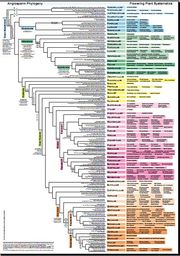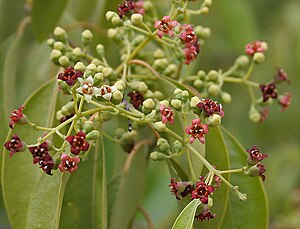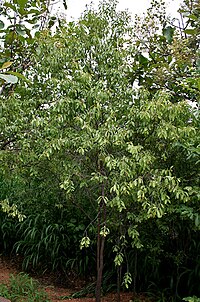Santalum album
Read community contributed articles on biodiversity & environment || Cultural practices & mythological stories related to Indian biodiversity || Official documents related to environment || NGOs, Blogs and Websites || Environment-related video collection || Plants of India || Mammals of India || Facebook || Twitter
Share this page: Santalum album
Sandalwood is an economically important plant and has been cultivated for several centuries for the fragrance of its oil. Due to extensive and sometimes, illegal cutting of native Sandalwood trees, this species has become vulnerable to extinction. S. album is native to South/South-East Asia, possibly Indonesia. Another species Santalum spicatum is native to Australia.
Click here to see all Semantic Properties associated with this page
Please note that the above slideshow is automatically created by searching Flickr and does not contain manually curated images. Hence, it is likely that some images may not be exactly of Santalum album.
Click on the tabs below to know more...
- Species identity and nomenclature
- Current Wikipedia entry
- Binomial Classification
- Morphological features
- Habitat and Geographical Spread
- Maps
- Medicinal Importance
- Cultural significance
- Commercial importance and cultivation
- Summary of PubMed articles
- Summary of NCBI molecular data
- External Links
- Images and Videos
| Parameter | Value(s) | References See complete references in the References section at the end |
|---|---|---|
| Names of users who have contributed to this species page | Gauravm | |
| Date on which this page was first created | 2010/09/01 | |
| This page was last modified on: | 6 September 2010 15:19:53 | |
| Name of the species | Santalum album | |
| ID on Encyclopedia of Life | ||
| Synonyms | Please check Binomial Classification section for synonyms. | |
| Common English Names | Indian Sandalwood, White Sandalwood | |
| Common Hindi Names | चन्दन Chandan | |
| Common Indian names | चंदन Chandan, संदल Sandal (Hindi); চংদন Chandan (Manipuri); चंदन Chandan, gandhachakoda (Marathi); Anukkam, Asam, சந்தநம் Chandanam (Tamil); ചംദനമ് Chandanam, chandana-mutti (Malayalam); Bhadrasri, చందనమ్ Chandanamu (Telugu); Agarugandha, bavanna, bhadrasri, ಚಂದಲ Chandala (Kannada); চংদন্ Chandan, শ্ৱেতচংদন Shwetchandan (Bengali); valgaka (Oriya); Sandal safaid (Urdu); अनिंदिता Anindita, Arishta-phalam, Bhadrasara, चंदनम् Chandanam (Sanskrit) | Flowers of India |
| Origins/Meanings of the common names | S. album is the type species of the genus Santalum, nominated by Linnaeus in the first botanical description; this was published in Species Plantarum in 1753 with the note "Habitat in India". The species name, Santalum ovatum, used by Robert Brown in Prodromus Florae Novae Hollandiae (1810) was described as a synonym of this species by Alex George in 1984. The epithet album refers to the 'white' of the heartwood. | Wikipedia |
Taxonomy from Encyclopedia of Life
If nothing is displayed in this section, it means the EoL ID has not been defined. Please click on Edit with form button on top and follow the instructions for filling in the EoL ID
{{#EoLOnlyHierarchy:}}
Taxonomy filled in form

Click here for the PDF of the phylogeny
| Taxon | Value |
|---|---|
| Regnum (Kingdom) | Plantae |
| Division | Magnoliophyta |
| Class | Magnoliopsida |
| Order | Santalales |
| Family | Santalaceae |
| Genus | Santalum |
| Source of data | Encyclopedia of Life |
| ||||||||||||||||||||
| Division | Taxon details | Taxon morphology details |
|---|---|---|
| Magnoliophyta | Also called Angiospermae. The ancestors of flowering plants diverged from gymnosperms around 245–202 million years ago, and the first flowering plants known to exist are from 140 million years ago. They diversified enormously during the Lower Cretaceous and became widespread around 100 million years ago, but replaced conifers as the dominant trees only around 60-100 million years ago. | These are seed plants like Gymnosperms, but can be differentiated by the presence of flowers, seeds containing endosperm and seeds that produce a fruit. Angiosperms are the most diverse and highly evolutionarily successful group of land plants. |
| ||||||||||||||||||||
| Class | Taxon details | Taxon morphology details |
|---|---|---|
| Magnoliopsida | Magnoliopsida is the scientific name for dicots. This class contains about ~1,99,350 species of Angiosperms. Eudicots are a subset of Dicots. Based on chloroplast DNA sequences, the divergence date between monocots and dicots is estimated to be ~200 million years, with a 40 million years uncertainty. | Dicots are diverse in habit, with half of all the species being more or less woody-stemmed - a reflection of the usual presence of a vascular cambium in the class. Annuals, biennials, vines, epiphytes, aquatics, parasites, and saprotrophs are also well represented in dicots. Vascular bundles of the stem are usually borne in a ring that encloses the pith. Vessel elements present except in some putatively primitive woody or aquatic families. Most dicots have a primary root system derived from the radicle, although some have an adventitious root system commonly seen in the class of monocots. Cotyledons are usually 2, seldom 1, 3, or 4. Leaves are mostly net-veined. |
|
|
| Family | Taxon details | Taxon morphology details |
|---|---|---|
| Santalaceae |
|
Based on classification
| Family | Taxon details | Taxon morphology details |
|---|---|---|
| Santalaceae |
More details can be found in the Binomial Classification section.
Morphology from Encyclopedia of Life
If nothing is displayed in this section, it means the EoL ID has not been defined. Please click on Edit with form button on top and follow the instructions for filling in the EoL ID
{{#EoLOnlyDescription:}}
General morphology
| Parameter | Value(s) | References See complete references in the References section at the end |
|---|---|---|
| General morphological features of the plant |
| Seed dispersal mechanism | ||
|---|---|---|
| Bloom type | Perennial | |
| Life cycle of the plant | S. album is a hemi-parasite. It colonizes the roots of other plants to grow. Sandalwood also prefers to be grown alongside leguminous plants such as Acacias, Casuarinas. | FAO |
How to identify this species
For a detailed description, refer to the General Morphology details above
| Parameter | Value(s) | References See complete references in the References section at the end |
|---|---|---|
| Type of plant | Woody (Tree/Shrub) | |
| Plant height | More than 10 feet | Images |
| Flower color | Lavender/Purple | Dave's Garden |
| Flower shape | ||
| Floral symmetry | ||
| Phyllotaxy of leaves | ||
| Leaf shape | ||
| Is the leaf petiolated or sessile? | ||
| Is the leaf simple or compound? |
| Parameter | Value(s) | References See complete references in the References section at the end |
|---|---|---|
| IUCN Conservation Status | Vulnerable | Encyclopedia of Life |
| Indian States in which the species has been documented | Andhra Pradesh,Bihar,Goa,Gujarat,Karnataka,Kerala,Madhya Pradesh,Maharashtra,Orissa,Rajasthan,Tamil Nadu,Tripura,Uttar Pradesh | Plant Database of India |
| Locations at which the species has been documented | Ahmednagar;Ajmerkola;Amaravati;Bangalore;Belgaum;Bellary;Bhagalpur;Bhopal;Bidar;Bijapur;Bombay;Buldana;Cannanore;Chamrajnagar;Chikmaglore;Chitradurga;Chittaurgarh;Coimbatore;Dakshin Kannada;Dhar;Dharmapuri;Dharwad;Goa
Gorakhpur;Gwalior;Hassan;Hyderabad;Indore;Jaipur;Jhalawar;Kodagu;Kolar;Kolar;Kolhapur;Kurnool;Kurnool;Madras;Malappuram;Medak;Mysore;Narasimhapur;Nasik;Nasik;Nilgiri;North East Districts;North Kanara;Osmanabad;Palaghat;Pulni;Pune;Raigad;Raigarh;Raipur;Rathnagiri;Ratlam;Rewa;Salem;Sambalpur;Satara;Shimoga;South Arcot;Srikakulam;Surguja;Tiruchi;Tirunelveli;Tumkur;Udaipur;Uttar Kannada;Visakhapatnam;Yawatmal |
Plants Database of India |
| Biotic zones inhabited | Eastern Ghats, Western Ghats, Central Deccan Plateau, Indo-Gangetic Plain | Based on Plants Database of India |
| Details about the habitat | Sandalwood is found in the drier regions in South India, in the states of Karnataka and Tamil Nadu, up to 1400 m. Formation of heartwood, which is the source of the sandalwood oil, is said to be best between 600 m and 900 m. Moderate rainfall (850-1200 mm) spread over several months and much sunshine are conducive to good growth.
S. album has become naturalized in parts of Rajasthan, Maharashtra, Madhya Pradesh and Uttar Pradesh and has been introduced into a number of other Indian states. The wood of trees outside their natural range, however, is very variable with respect to oil content and sometimes has little or no aroma. |
FAO |
| Is this species native to India? | Yes | Wikipedia |
| Is the species indigenous/endemic to Sub-Himalayan regions? | ||
| Is the species indigenous/endemic to Western Ghats? | ||
| Is the species indigenous/endemic to Eastern Ghats? |
More plants native to India
| ||||||||||||||||||||||||||||||||||||||||||
If no maps are displayed below, it means the required data is absent. Click on "Edit with form" button on top of the page to add this information.
{{#generateMap:Andhra Pradesh,Bihar,Goa,Gujarat,Karnataka,Kerala,Madhya Pradesh,Maharashtra,Orissa,Rajasthan,Tamil Nadu,Tripura,Uttar Pradesh|Santalumalbum_brahma.svg|align=center}}
| Parameter | Value(s) | References See complete references in the References section at the end |
|---|---|---|
| Does this species have any medicinal use? | Yes |
|
Other plants of the same family having medicinal use:
|
| Parameter | Value(s) | References See complete references in the References section at the end |
|---|---|---|
| General types of ailments this species is used for treating | ||
| Specific ailments for which the species is used | ||
| Medicinal systems which use this plant | Ayurveda, Folk Medicine | |
| Details of Medicinal use | ||
| Parts of the plant used for treatment | ||
| Names of some medicinal active compounds in this plant, if known. | ||
| Details of the active chemical compounds found in this plant | ||
| Is the molecular basis of the medicinal action known? | ||
| Details of molecular basis of action | ||
| Are the toxic effects of consumption of this plant known? | ||
| Details of the toxic effects of the plant species | ||
| Have there been validation/clinical studies related to this plant? | ||
| Details of the clinical studies related to the plant species |
| Parameter | Value(s) | References See complete references in the References section at the end |
|---|---|---|
| Is this plant/plant-derived product used in food preparations? | Yes | User-reported |
| Part(s) of the plant used in the food preparations | ||
| Details of use in food preparations | ||
| Does this species have any religious significance? | Yes | User-reported |
| Religions which mention/give significance to this species | Hinduism | Images |
| Religious occasions | Hindu Puja | Gauravm |
| Details of religious use | The heartwood of Sandal is used in religious pujas to make "Chandan pastes". These pastes are applied to the forehead of gods and of the worshipers. Sandalwood oil is also used in incense sticks used in such pujas. The oil is also offered in the sacred Yajna fires. | Gauravmhttp://www.fao.org/docrep/v5350e/v5350e08.htm |
| Parameter | Value(s) | References See complete references in the References section at the end |
|---|---|---|
| Is this plant cultivated commercially in India? | Yes | FAO |
| Uses for which the plant is commercially cultivated | Human consumption, Medicinal use, Cosmetic use, Religious use, Wood | FAO |
| Plant parts of commercial value | Root, Stem, Bark, Seeds | FAO |
| Products where this plant is used | User-reported | |
| Description of use | Almost all of the sandalwood oil in the world is produced from the S.album. The highest content is in the roots followed by the heartwood. Sandalwood oil is used in high-quality perfumes and cosmetics and Ayurvedic creams. India is the largest producer of Sandalwood. Production is based almost entirely on exploitation of wild trees.
Sandalwood is also popular as carving wood and for making souvenirs and toys. The wood is used in religious practices in Hinduism. The cotyledons and kernel of sandal seeds contain a fixed oil which has drying properties. Oil-free sandal seed meal is rich in protein and could be utilized as an animal feed if available in sufficient quantities. The oil may also be used as a food additive (GRIN) |
FAO |
| States where this plant is cultivated commercially | Andhra Pradesh, Goa, Karnataka, Kerala, Maharashtra, Tamil Nadu | Based on FAO |
| Best period for planting this plant | Summer | |
| Best period for harvesting this plant | Summer | |
| Method of propagation | Seeds, Vegetative propagation, Micropropagation | Dave's Garden, Google Scholar search |
| Water requirement of this plant | Average | |
| Pests and Diseases affecting this plant during cultivation | Spike disease | FAO |
| Other considerations while cultivating this plant | Well drained soil needed. Plant in early summer/late spring. The seeds should be soaked in Gibberellic acid at the rate of 0.01grams per litre ofcool boiled water.
Young seedlings need lots of water, but later on they mostly manage on their own. Average rainfall from 800mm to 1800mm per annum. It needs company of leguminous plants to grow happily. Sesbania formosa is an ideal intermediate host which it will eventually kill in around 3 to 5 years. This gives its long term host time to establish. Plant spacings are; Intermediate host/sandalwood at 0.5metre and these pairs 3.0m spacing along a row. Long term host such as Pterocarpus indicus planted in between these. Row spacings are 4.0 metres. (Dave's Garden) Plants which you do not want killed should be planted 25m away from this tree. The plant kills citrus trees. (Dave's Garden) Trees above 60 cm girth can be harvested during the post-monsoon period.The harvested heartwood from stem and roots is chopped and powdered. Sandalwood oil is produced by Steam distillation of this powdered wood. In the 1990's the oil sold for >$180/kg. (FAO) |
Dave's Garden, FAO |
Pubmed Word cloud
This word cloud is obtained using the tool LigerCat by searching the Pubmed database. LigerCat builds the cloud from the most relevant Medical Subject Headings (MeSH) terms. Each term's relative size indicates how many times it appears in the PubMed search results. Click on a term to access the full LigerCat cloud, with live PubMed search capabilities. LigerCat has been developed for the Biology of Aging Project.
The page may take some time to load since LigerCat is searching the entire PubMed database and sending us the results in real time.
- If there is an error message below, it means that there is no retrievable information available on NCBI
- If the number of nucleotide sequences is less than 100, very little genomic work has been done on this species. A respectable number of nucleotide sequences is above 10000.
- Most of the nucleotide sequences may come from three sources:
- Studies on single genes, where people try to sequence genes such as some specific dehydrogenases important,say, for tannin production
- Sequences of Ribosomal Internal Transcribed Spacer, whose sequence is used for generating molecular phylogenetic trees to establish species relationships
- Expressed Sequence Tags (ESTs) which can tell about which genes are present and expressed in the species at a particular time in the given tissue
{{#queryDB:taxonomy |Santalum album }}
| Parameter | Value(s) | References See complete references in the References section at the end |
|---|---|---|
| Details of modern scientific knowledge available for this species | A small, insignificant number of nucleotide sequences, mainly of the protein sesquiterpene synthase, are available on NCBI (Sep 2010). Most of the other data pertains to composition of the sandalwood oil. There have been a couple of studies trying to find out the genetic diversity in different sandalwood populations across Australia and India | Google Scholar Search |
| Are herbarium specimen available for this species? | ||
| Institutes having herbarium samples |
If nothing is displayed in this section, it means the EoL ID has not been defined. Please click on Edit with form button on top and follow the instructions for filling in the EoL ID
{{#EoLOnlyAdditionalInfo:}}
References
Flowers of India (Web): Flowers of India entry, Accessdate=2010-09-01
EoL (Web): Encyclopedia of Life entry, Accessdate=2010-09-01
Wikipedia (Web): Wikipedia entry on Santalum album, Accessdate=2010-09-01
FAO (Web): UN Food and Agriculure Organization's Document on Sandalwood oil, Accessdate=2010-09-01
Plants Database of India (Web): Plants Database of India entry, Accessdate=2010-09-01
Dave's Garden (Web): Dave's Garden entry, Accessdate=2010-09-01

